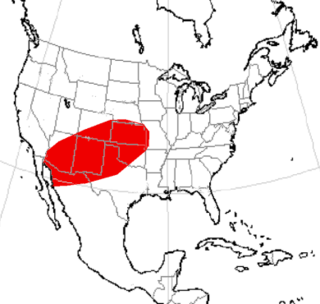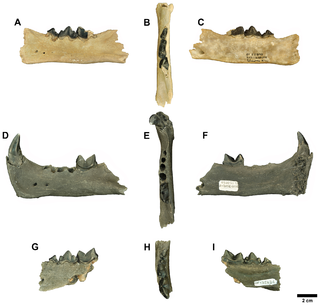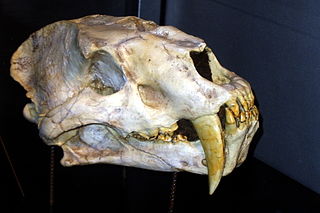
Machairodus is a genus of large machairodont or ''saber-toothed cat'' that lived in Africa, Eurasia and North America during the late Miocene. It is the animal from which the subfamily Machairodontinae gets its name and has since become a wastebasket taxon over the years as many genera of sabertooth cat have been and are still occasionally lumped into it.

Dinofelis is an extinct genus of machairodontine, usually classified in the tribe Metailurini. It was widespread in Europe, Asia, Africa and North America from 5 million to about 1.2 million years ago. Fossils very similar to Dinofelis from Lothagam range back to around 8 million years ago, in the Late Miocene.

Homotherium is an extinct genus of machairodontine scimitar-toothed cat that inhabited North America, South America, Eurasia, and Africa during the Pliocene and Pleistocene epochs from around 4 million to 12,000 years ago. In comparison to Smilodon, the canines of Homotherium were shorter, and it was probably adapted to running down rather than ambushing prey.

A saber-tooth is any member of various extinct groups of predatory therapsids, predominantly carnivoran mammals, that are characterized by long, curved saber-shaped canine teeth which protruded from the mouth when closed. Saber-toothed mammals have been found almost worldwide from the Eocene epoch to the end of the Pleistocene epoch.

Machairodontinae is an extinct subfamily of carnivoran mammals of the family Felidae. They were found in Asia, Africa, North America, South America, and Europe from the Miocene to the Pleistocene, living from about 16 million until about 10,000 years ago.

Smilodontini is an extinct tribe within the Machairodontinae or "saber-toothed cat" subfamily of the Felidae. The tribe is also known as the "dirk-toothed cats". They were endemic to South America, North America, Europe, Asia, and Africa during the Miocene to Pleistocene, from 10.3 mya—11,000 years ago, existing for approximately 10.3 million years.
Paramachaerodus is an extinct genus of saber-tooth cat of the subfamily Machairodontinae, which was endemic to Europe and Asia during the Middle and Late Miocene from 15 to 9 Ma.

Xenosmilus is an extinct genus of homotherin machairodontine that was discovered in Florida in 2001. It has one species, Xenosmilus hodsonae.

Megantereon was a genus of prehistoric machairodontine saber-toothed cat that lived in North America, Eurasia, and Africa. It is closely related to and possibly the ancestor of Smilodon.

Adelphailurus is an extinct genus of metailurin machairodontine (saber-toothed) cat that inhabited western North America during the middle Pliocene. It is monotypic, containing only the species Adelphailurus kansensis.

Barbourofelidae is an extinct family of carnivorans of the suborder Feliformia, sometimes known as false saber-toothed cats, that lived in North America, Eurasia and Africa during the Miocene epoch and existed for about 7.9 million years. Thought to be an independent lineage from the Nimravidae and Machairodontinae, which had all attained elongated canines, recent research argues that it may be a subfamily of the Nimravidae, extending its biochronological range into the Miocene, although this issue is not yet fully resolved.
Miomachairodus is an extinct genus of large machairodontine containing only a single species, Miomachairodus pseudailuroides. It is known from Miocene-age fossils in China and Turkey and persisted until the Late Miocene. Fossils of this machairodont have been found in the Vallesian-age Bahe Formation in Shaanxi, China, and Yeni Eskihisar in Anatolia. This Turkish site is of Miocene age and is well known for its pollen studies.

Nimravides is a genus of extinct saber-toothed cats that lived in North America during the Late Miocene, between 10.3 and 5.332 Ma. Despite its scientific name, Nimravides does not belong to the Nimravidae, but is a true cat belonging to the family Felidae.

Homotherini is a tribe of saber-toothed cats of the family Felidae. The tribe is commonly known as scimitar-toothed cats. These saber-toothed cats were distributed en North America, Europe, Asia, Africa, and South America from the Miocene to Pleistocene living from c. 23 Ma until c. 12,000 years ago.
Lars Werdelin is a Swedish paleontologist specializing in the evolution of mammalian carnivores. His areas of scientific interest include the evolutionary interaction of carnivores and hominins in Africa, the evolution and phylogeny of carnivore clades such as the Machairodontinae, the lynxes and the Hyaenidae.

Rhizosmilodon is an extinct genus of saber-tooth cat of the subfamily Machairodontinae that lived during the Early Pliocene and was discovered in the U.S. state of Florida. Comparable in size to a medium-sized modern jaguar at about 165 lb. in weight, fossils of Rhizosmilodon are known only from Florida. The best specimens for this species are its lower jaw and teeth, which carry intermediate characteristics between advanced forms such as Smilodon and primitive forms such as Paramachairodus. It was likely an ambush predator, preying on animals such as deer, tapirs and horses.

Amphimachairodus is an extinct genus of large machairodonts. It is also a member of the tribe Homotherini within Machairodontinae and is most closely related to such genera as Xenosmilus, Homotherium itself, and Nimravides. It inhabited Eurasia, Northern Africa and North America during the late Miocene epoch.
Yoshi is an extinct genus of machairodontine sabertooth cat in the tribe Metailurini. Its fossils were described from Turolian deposits from the Miocene epoch of the Balkan Peninsula in 2014 and specimens from China once thought to belong to Metailurus. The name comes from that of the lead author's pet cat. It has been described as potentially being synonymous with Metailurus, though this is difficult to confirm at present. The type specimen is a skull that bears remarkable similarities with the modern cheetah. Yoshi is intermediate in size between a lynx and cougar, and based on several as-yet unpublished skeletons, may have had a similar lifestyle to the cheetah, being better built for speed and fast pursuit than most other machairodonts, which were more suited to ambush and hunting large, relatively slow moving animals.
Tchadailurus is a genus of machairodontine felid from the late Miocene of Chad, Africa.
Taowu is an extinct genus of machairodonts, a type of saber-toothed cat. It lived during the Early Pleistocene about 2.5 million years ago in East Asia. So far, only one skull is known, found in northern China. Based on this, a relatively small representative of the saber-toothed cats can be reconstructed, which only reached the size of a present-day leopard. In its dentition characteristics, it mediates between phylogenetic older forms such as Amphimachairodus and younger members such as Homotherium. The genus was scientifically described in 2022, but the find material was recovered as early as the 1930s.















